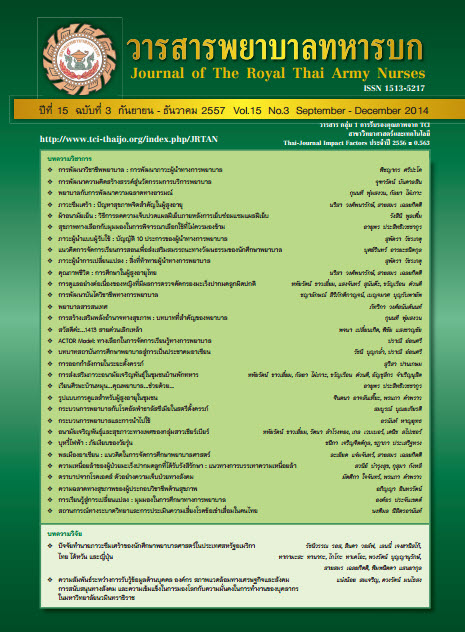ผลของการสอนการรับส่งเวรโดยใช้เทคนิค SBAR ต่อความรู้ ทัศนคติ และทักษะในการรับส่งเวรของนักศึกษาพยาบาล Effects of Teaching by Using SBAR Technique on Knowledge Attitude and Practice in Taking and Giving Report Among Nursing Students
Keywords:
การรับส่งเวร, เทคนิค SBAR, ความรู้, ทัศนคติ, ทักษะ, Taking and Giving Report, SBAR Technique, Knowledge, Attitude, PracticeAbstract
การวิจัยกึ่งทดลองครั้งนี้มีวัตถุประสงค์เพื่อศึกษาความรู้ ทัศนคติ และทักษะในการรับส่งเวรของกลุ่มทดลองและกลุ่มควบคุม ก่อนและหลังการสอน และเปรียบเทียบความรู้ ทัศนคติ และทักษะในการรับส่งเวรทั้งภายในกลุ่มและระหว่างกลุ่มก่อนและหลังการสอน ประชากรคือนักศึกษาพยาบาลชั้นปีที่ 4 ปีการศึกษา 2556 คณะพยาบาลศาสตร์เกื้อการุณย์ มหาวิทยาลัยนวมินทราธิราชจำนวน 197 คน กลุ่มตัวอย่าง 60 คน คัดเลือกด้วยวิธีการสุ่มแบบแบ่งชั้น โดยใช้เกรดเฉลี่ยแบ่งออกเป็น 3 กลุ่มคือ กลุ่มสูง-กลาง-ต่ำ เพื่อจัดเข้ากลุ่มทดลองและกลุ่มควบคุม กลุ่มละ 30 คน กลุ่มทดลองได้รับการสอนการรับส่งเวรโดยใช้เทคนิค SBAR ส่วนกลุ่มควบคุมได้รับ การสอนตามปกติ เครื่องมือที่ใช้ในการทดลองคือแผนการสอนเรื่องการรับส่งเวรโดยใช้เทคนิค SBAR และเครื่องมือที่ใช้ในการเก็บรวบรวมข้อมูลคือแบบวัดความรู้ ทัศนคติ และทักษะในการรับส่งเวร ตรวจสอบความตรงตามเนื้อหา โดยผู้ทรงคุณวุฒิ 5 ท่าน ความเที่ยงของแบบวัดในส่วนความรู้และส่วนทัศนคติในการรับส่งเวร มีค่าสัมประสิทธิ์แอลฟาครอนบาค
เท่ากับ .78 และ .82 ตามลำดับและส่วนทักษะในการรับส่งเวร มีค่า inter-scoror reliability เท่ากับ .80 เก็บรวบรวมข้อมูลด้วย วิธีการวัดก่อนและหลังการสอน วิเคราะห์ข้อมูลโดยใช้สถิติ dependent t-test และ independent t-test ผลการวิจัยพบว่า 1. ความรู้ ทัศนคติ และทักษะในการรับส่งเวรของกลุ่มทดลอง หลังการสอนมากกว่าก่อนการสอนอย่างมีนัยสำคัญทางสถิติที่ระดับ .001 ในขณะที่กลุ่มควบคุมแตกต่างกันอย่างไม่มีนัยสำคัญทางสถิติ t-align: -webkit-auto; text-indent: 0p2. ความรู้ ทัศนคติ และทักษะในการรับส่งเวรของกลุ่มทดลอง หลังการสอนมากกว่ากลุ่มควบคุมอย่างมีนัยสำคัญทางสถิติที่ระดับ .001 ผลการวิจัยชี้ให้เห็นว่าการสอนการรับส่งเวรโดยใช้เทคนิค SBAR สามารถพัฒนาความรู้ ทัศนคติ และทักษะในการรับส่งเวรได้จริง เทคนิค SBAR น่าจะเป็นอีกทางเลือกหนึ่งที่นักศึกษาพยาบาล ครูคลินิก และพยาบาลวิชาชีพนำมาใช้เพื่อเพิ่มประสิทธิภาพในการรับส่งเวร
This quasi-experimental research aimed to study knowledge, attitude and practice (KAP) in taking and giving report among nursing students before and after teaching in experimental and control groups and to compare KAP in taking and giving report among nursing students before and after teaching in each group and between groups. The 60 samples were stratifid sampling, according to GPA, from the population of 197 fourth-year- nursing students of 2013 academic year in Kuakarun Faculty of Nursing, Navamindradhiraj University. Then, the samples were assigned into two equal groups, experimental and control groups. The experimental group received teaching by using SBAR technique in taking and giving report while the control group received teaching by using ordinary technique in taking and giving report. The research instruments developed by the researchers were 1) Lesson Plan of SBAR Technique in Taking and Giving Report, served as
experimental tool, and 2) Test of KAP in Taking and Giving Report. The content validity of both instruments was approved by fie expertises. The reliabilities of knowledge and attitude tests measured as Cronbach’s coeffiient alpha were .78 and .82, respectively, and inter-scoror reliability of practice was .80 The randomized pretest-posttest control group design was used in this study. The data were analyzed by dependent t-test and independent t-test. The major fidings were:
1. The KAP in taking and giving report among nursing students in experimental group after teaching was statistically signifiant higher than before teaching at .001, whereas there was no signifiant difference in the control group. 2. The KAP in taking and giving report among nursing students in the experimental group after teaching was statistically signifiant higher than that in the control group at .001 In conclusion, the SBAR is a useful technique in taking and giving report. It highly improved KAP in taking and giving report among nursing students. Based on the success experiences of this study, the SBAR technique could be a better alternation for nursing students, faculties, and registered nureses to improve
quality in taking and giving report.
Downloads
Downloads
How to Cite
Issue
Section
License
บทความหรือข้อคิดเห็นใดใดที่ปรากฏในวารสารพยาบาลทหารบกเป็นวรรณกรรมของผู้เขียน ซึ่งบรรณาธิการหรือสมาคมพยาบาลทหารบก ไม่จำเป็นต้องเห็นด้วย
บทความที่ได้รับการตีพิมพ์เป็นลิขสิทธิ์ของวารสารพยาบาลทหารบก
The ideas and opinions expressed in the Journal of The Royal Thai Army Nurses are those of the authors and not necessarily those
of the editor or Royal Thai Army Nurses Association.






